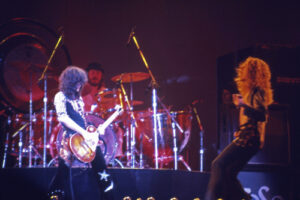
Feature Photo: Sterling Munksgard / Shutterstock.com
Remember is a word that invites listeners to look back, whether with bittersweet longing or triumphant celebration, and it’s no surprise that some of the most memorable tracks in music history use it to evoke a universal connection.
Cate Le Bon’s hauntingly introspective “Remembering Me” delves into the fragility of self-identity, wrapped in a dreamlike art-pop tapestry. The Motels’ “Remember the Nights” captures the shimmering glow of new wave, blending heartbreak with an irresistible melody. Cat Stevens’ “(Remember the Days of the) Old Schoolyard” is a playful ode to youthful innocence and the memories that shape us. The J. Geils Band’s “Do You Remember When?” blends soulful melodies with longing, steeped in the band’s signature rock energy. Harry Chapin’s “Remember When the Music” is a heartfelt tribute to a lost era of idealism, underscored by his storytelling brilliance.
Pink Floyd’s “Remember a Day” explores the wistful echoes of childhood dreams, brought to life with Richard Wright’s ethereal songwriting. The Ramones’ “Do You Remember Rock ‘n’ Roll Radio?” is a raucous anthem to the golden age of rock, fueled by Phil Spector’s wall-of-sound production. Sarah McLachlan’s poignant “I Will Remember You” reflects on love and loss with a tenderness that feels timeless. Firefall’s “Just Remember I Love You” offers a soft rock balm for life’s hardest moments, its sincerity shining through every note. Finally, Aerosmith’s electrifying cover of “Remember (Walking in the Sand)” injects raw energy into a classic tale of heartbreak, proving their mastery of reinvention.
# 10 -Remembering Me – Cate Le Bon
Cate Le Bon’s “Remembering Me,” a centerpiece from her 2022 album Pompeii, is a masterclass in restrained art pop, offering listeners a layered exploration of memory and self-awareness. Written and recorded during the solitude of the pandemic, the song reflects the stillness and introspection of that time. Crafted in a Victorian terrace in Cardiff owned by fellow Welsh musician Gruff Rhys, Pompeii carries the distinct sonic fingerprints of a world turned inward. Le Bon’s role as producer allowed her to guide the track’s intricate balance of synth-driven minimalism and emotive lyricism, creating a soundscape that feels both intimate and expansive.
Read More: Complete List Of Cate Le Bon Albums And Songs
# 9 – Remember the Nights – The Motels
“Remember the Nights” by The Motels captures the wistful yearning of love and memory, embodying the essence of 1980s new wave. Released in 1983 as the second single from their album Little Robbers, the track reflects the band’s signature blend of atmospheric pop and emotional storytelling. Written by lead singer Martha Davis and Scott Thurston, the song was produced by Val Garay, whose meticulous work on the album propelled The Motels into the spotlight. Recorded in Los Angeles, Little Robbers benefited from the precision and polish of Garay’s production, helping “Remember the Nights” peak at number 36 on the US Billboard Hot 100.
Read More: Top 10 Martha Davis And The Motels Songs
# 8 – (Remember the Days of the) Old Schoolyard – Cat Stevens
“(Remember the Days of the) Old Schoolyard” captures the wistful innocence of childhood and the unblemished joy of youthful love, a theme that Cat Stevens explores with a vibrant blend of nostalgia and sentimentality. Released as the lead single from his 1977 album Izitso, the track marked Stevens’ embrace of modern production techniques, blending his acoustic folk roots with the emerging sounds of synthesizers and electronic instrumentation. Produced by Jim Cregan, the song was recorded during the sessions for Izitso, which took place in several locations, including studios in Los Angeles and London. The single features a duet with Elkie Brooks, whose soulful voice complements Stevens’ tender reflections.
Read More: Jim Cregan: The ClassicRockHistory.com Interview
Read More: Top 10 Cat Stevens Songs
# 7 – Do You Remember When? – J. Geils Band
“Do You Remember When?” is a heartfelt track from the J. Geils Band’s landmark Freeze-Frame album, released on October 26, 1981, by EMI Records. This record became a pivotal moment in the band’s career, marking their rise to mainstream prominence while simultaneously showcasing their ability to blend emotional depth with their signature rock and R&B influences. Produced by the band’s keyboardist and arranger Seth Justman, the song reflects the meticulous craftsmanship that defined the Freeze-Frame sessions, which took place at Long View Farm in Massachusetts. With Peter Wolf on lead vocals delivering a raw, introspective performance, the track stands out as a poignant reflection on lost love and bittersweet memories.
Read More: 10 J. Geils Band Songs Fans Love
# 6 – Remember When the Music – Harry Chapin
Harry Chapin’s “Remember When the Music” resonates as a heartfelt ode to the transformative power of music and its role in shaping a hopeful and united society. Released in 1980 on his album Sequel, the track was written as a poignant tribute to former New York congressman Allard K. Lowenstein, who was tragically assassinated earlier that year. Chapin later remarked that the song took on an even deeper meaning following the shocking death of John Lennon in December 1980, making it a powerful meditation on loss and the enduring impact of shared ideals. Produced by Stephen Chapin and recorded in New York City, the track features Chapin’s signature acoustic storytelling style, interwoven with gentle orchestration that highlights its emotional gravity. Chart-wise, the song achieved moderate success, reaching number 47 on the Billboard Charts.
Read More: Top 10 Essential Harry Chapin Songs
# 5 – Remember A Day – Pink Floyd
“Remember a Day” captures a wistful nostalgia that echoes through Pink Floyd’s experimental era, showcasing the reflective lyricism and ethereal composition of Richard Wright. Featured on their 1968 album A Saucerful of Secrets, the track conveys a longing for the innocence of childhood through its dreamy atmosphere and poetic imagery. Recorded at De Lane Lea Studios in London over two sessions in 1967, the song’s instrumentation bridges the band’s transition from Syd Barrett’s psychedelic influence to their progressive rock identity. Wright’s vocals and Farfisa organ provide the foundation, while Barrett’s slide guitar work weaves an otherworldly texture into the piece, enhancing its reflective tone.
Read More: Top 10 Pink Floyd Deep Tracks
# 4 – Do You Remember Rock ‘n’ Roll Radio? – Ramones
“Do You Remember Rock ‘n’ Roll Radio?” stands as a nostalgic yet biting critique of the music industry, encapsulating the Ramones’ ethos while pushing their sound into uncharted territory. Released on End of the Century in 1980, the track marked a pivotal collaboration with producer Phil Spector, whose lush, layered production introduced saxophones, organ flourishes, and a wall of sound that contrasted sharply with the band’s raw punk roots.
Read More: 11 Essential Ramones Songs
# 3 – I Will Remember You – Sarah McLachlan
“I Will Remember You” captures the haunting beauty of Sarah McLachlan’s songwriting, blending poignant lyrics with a melody that lingers long after the final note fades. Written in collaboration with Séamus Egan and Dave Merenda, the song was inspired by Egan’s instrumental “Weep Not for the Memories.” First appearing on the The Brothers McMullen soundtrack in 1995, McLachlan’s version found early success, peaking at number 65 on the Billboard Hot 100 and number 10 in Canada. The live version, featured on her 1999 album Mirrorball, catapulted the track into even greater recognition, reaching number 14 on the Billboard Hot 100 and earning McLachlan a Grammy Award for Best Female Pop Vocal Performance in 2000.
Read More: Top 10 Sarah McLachlan Songs
# 2 – Just Remember I Love You -Firefall
“Just Remember I Love You” is a heartfelt ballad by Firefall, released in 1977 as the lead single from their second studio album, Luna Sea. Written by band member Rick Roberts, the song became one of the band’s signature tracks, blending soft rock with a tender lyrical theme of reassurance and love. Recorded at Criteria Studios in Miami, Florida, the track featured backing vocals by Timothy B. Schmit of Eagles fame, adding an ethereal layer to its lush arrangement. The single peaked at number 11 on the Billboard Hot 100, reached number nine on the Cashbox chart, and claimed the top spot on the Billboard Easy Listening chart, showcasing its widespread appeal. Its success extended to Canada, where it also topped the Adult Contemporary chart.
Read More: Top 10 Firefall Songs
# 1 – Remember (Walking In The Sand) – Aerosmith
Aerosmith’s rendition of “Remember (Walking in the Sand)” brings a gritty, hard rock edge to the 1964 hit originally performed by the Shangri-Las. Released in 1979 as a single from their sixth studio album, Night in the Ruts, this cover showcases Aerosmith’s ability to reimagine a classic while retaining its emotional core. Co-produced by Gary Lyons, the track features uncredited backing vocals from Mary Weiss of the Shangri-Las, bridging the past with the band’s rock ethos. The song reached number 67 on the Billboard Hot 100 and climbed to number 29 on the Canadian RPM singles chart, marking a moderate commercial success during a tumultuous period for the band.
Read More: Aerosmith’s Best Song On Each Of Their Studio Albums
Read More: Tom Hamilton of Aerosmith: The ClassicRockHistory.com Interview
Read More: Artists’ Interviews Directory At ClassicRockHistory.com
Read More: Classic Rock Bands List And Directory
Updated August 23, 2025









































